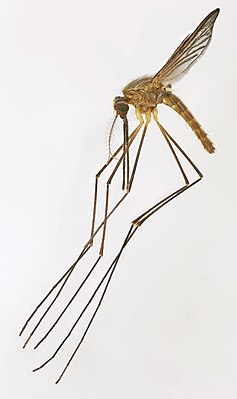Anopheles plumbeus
| Anopheles plumbeus | ||||||||||||
|---|---|---|---|---|---|---|---|---|---|---|---|---|

Anopheles plumbeus |
||||||||||||
| Systematics | ||||||||||||
|
||||||||||||
| Scientific name | ||||||||||||
| Anopheles plumbeus | ||||||||||||
| ( Stephens , 1828) |
Anopheles plumbeus is a species of the malaria mosquito ( Anopheles ), to which Anopheles nigripes , corsicanus and intermedius are now synonymous.
distribution and habitat
The species is widespread in Germany, but not common. It occurs all over Europe and Asia Minor , it occurs in large numbers in the Caucasus .
From the primary habitat in water-filled tree hollows, the species has extended to numerous man-made bodies of water, e.g. B. Rainwater retention basins and waste water tanks, which offer living space especially for the summer generation. They also tolerate heavily polluted water and breed even in tin cans that have been left standing. The species is increasingly registered in Central Europe and is said to be local, e.g. B. in Belgium, are among the mosquito species that are most annoying to humans. Individual strains of the species are more or less specialized in humans as hosts, but apart from that it stings a wide spectrum of reptile, bird and mammalian species, with mammals being preferred.
description
The larvae of Anopheles plumbeus are mainly found in the water-filled forks of beech and oak branches . It is the only European species of the genus that lives in tree hollows. The eggs are laid by the female on the wood above the water level, not directly into the water. In Central Europe two generations are given per year. The species overwinters in the larval stage, occasionally as an egg. Occurrence also in gardens and parks are widespread.
Anopheles plumbeus is a small, dark gray mosquito with tufts of white scales on the top. It can be found mainly on the edges of forests from June to autumn. Although it is considered to be prickly and could be infected with Plasmodia in experiments , Anopheles plumbeus is not considered to be of great importance as a malaria vector due to its low frequency . However, their potential importance as a vector may have been underestimated so far. In 1997 two children in a hospital in Duisburg were infected with Plasmodium falciparum by this species . The source of the infection was a little girl from Angola suffering from malaria.
swell
- ^ Walter Reed Biosystematics Unit: Systematic Catalog of the Culicidae, Anopheles plumbeus
- ^ Rubén Bueno-Marí & Ricardo Jiménez-Peydró (2011): Anopheles plumbeus Stephens, 1828: a neglected malaria vector in Europe. Malaria Reports 2011; volume 1: e2. doi : 10.4081 / malaria.2011.e2 download
- ↑ Heinz-Werner Baer: Anopheles and Malaria in Thuringia , VEB Gustav Fischer, Jena, 1960 (as Anopheles nigripes )
- ↑ Krüger, A., Rech, A., Su, X.-Z., Tannich, E. (2001): Two cases of autochthonous Plasmodium falciparum malaria in Germany with evidence for local transmission by indigenous Anopheles plumbeus. Tropical Medicine & International Health, 6: 983-985. doi : 10.1046 / j.1365-3156.2001.00816.x
Web links
- Information on Anopheles plumbeus at the European Center for Disease Prevention and Control (ECDC). (English)
